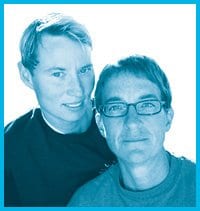Dykes and fags are different. Not exactly a news flash, huh? Everyone (well, every queer) knows that when it comes to the phallus, most fags grow their own while most dykes still have to buy them. And then there is the fact that dykes have twice as many “below the waist” penetration options as fags-not that either group necessarily chooses to use them.
We are also willing to bet, based on no further research, that more fags have more sex more often with more people, even when “married.” The stereotypes that guys are more interested in sex and gals in intimacy, we are fairly convinced, is still an accurate one. Just have a look at softball (yes, it’s that time of year again, but we promise, not another mention of the S word). Guys join the West End Slo-Pitch league to expand their sexual (and social) horizons and no one thinks a thing of it, while the dykes who break hearts in, and wreak havoc on, Mabel League team after Mabel League team are, well, notorious. And we don’t mean in a good way.
And the money thing. Face it-as a group, men make more money than women. The Goddess, in a truly misguided moment if there ever was one, tried to offset this fact by placing a man and a woman together as an income unit-the “traditional family.”
One unfortunate and, we are very sure, unintended consequence of queer coupling is that the average income of a fag couple is going to be way higher than the average income of a dyke couple. Sigh. This sometimes causes problems when we try to work toward common political goals across the gender divide: the dykes want to celebrate successes with potlucks and the fags want to rent a party boat.
But we want to explore two unexpected-and heretofore unexplained-differences between dykes and fags.
In theory, women are thought to have better social skills than men. Some say this is because women have to raise children, negotiate with the strange people from their partner’s family, and deal with snotty sales clerks who don’t want to honour discount coupons. Men, on the other hand, have to defend themselves and their kin folk against, well, other men. So they need to be ready to beat each other up at a moment’s notice, and perhaps for no really good reason.
But somehow, this division is reversed in queers. Dykes are actually not always that great at working through complex social situations. For example, lesbian parties are rarely very large (or lavish, but file that under “money”) because the various ex-lovers are busy packing up a U-Haul truck and “processing” until the next partner comes along. Even if you get to the party (potluck dish in hand), you are likely to be met with an awkward stare, since a) you are still happily involved with your current, b) your ex is already there and no one knows what to say, or c) you are new to the group and must be shunned for the requisite three months before being acknowledged.
Contrary to their gender socialization, fags have fantastic social skills. You can walk into a room filled with gay men you’ve never met before and make at least one friend for life. Of course, we know plenty of fags who have struggled to find the “in” crowd, or any crowd, but social activities abound (not only “You Know What” but also bowling and swimming and sailing and square dancing and naked parties and, of course, Stanley Park), and eventually every boy is embraced by his brothers.
In fact, the renowned social skills of fags are a boon to dykes. As one dyke explains it, “I was burned out on relationships with women and just wanted to have some fun and make new friends. I turned to fags because it’s so much easier to do it with them. Go up to a group of gay guys and introduce yourself and you will, more often than not, be immediately included and even end up with a few phone numbers. And they will call you back! Try that with a group of dykes and you’ll feel like you’re right back in high school and hating it.”
Maybe they all disrespect each other in the back room or alley, but at least in public, or at least in front of dykes, gay guys are the glue that holds social life together. We don’t entirely understand this, but it does seem that dykes are cliquey while fags are much more socially generous. But we’d like to see this change.
Tip: If you’re a dyke and a dyke walks up to you and introduces herself, don’t be afraid that responding pleasantly will commit you to moving in with her or be inappropriate if you already have a girlfriend. Take it in stages: try giving your first name for now, and waiting a few weeks to give out your last name and phone number.
What the fuck!

 Why you can trust Xtra
Why you can trust Xtra


